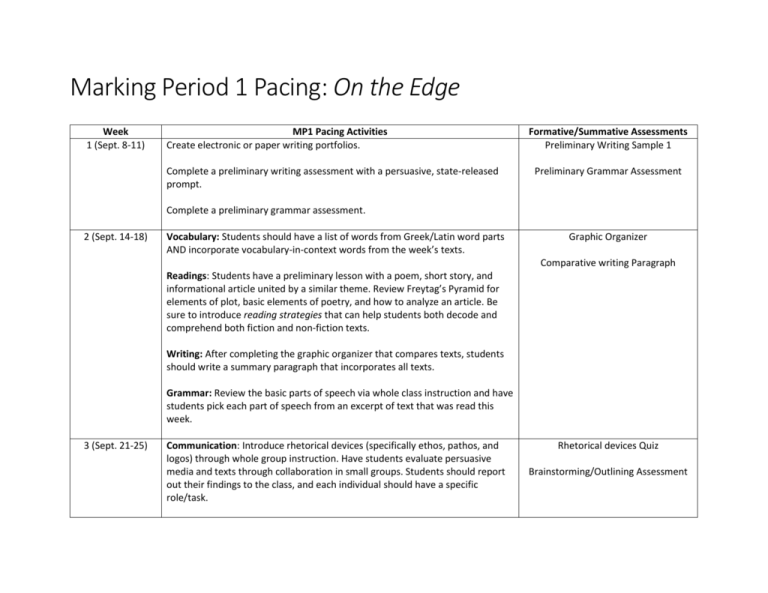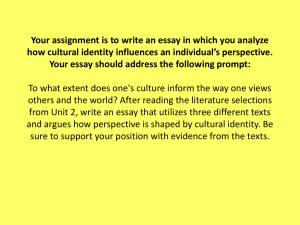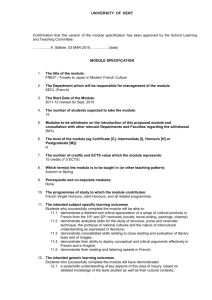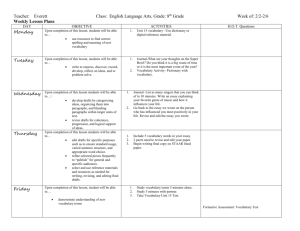On the Edge
advertisement

Marking Period 1 Pacing: On the Edge Week 1 (Sept. 8-11) MP1 Pacing Activities Create electronic or paper writing portfolios. Complete a preliminary writing assessment with a persuasive, state-released prompt. Formative/Summative Assessments Preliminary Writing Sample 1 Preliminary Grammar Assessment Complete a preliminary grammar assessment. 2 (Sept. 14-18) Vocabulary: Students should have a list of words from Greek/Latin word parts AND incorporate vocabulary-in-context words from the week’s texts. Graphic Organizer Comparative writing Paragraph Readings: Students have a preliminary lesson with a poem, short story, and informational article united by a similar theme. Review Freytag’s Pyramid for elements of plot, basic elements of poetry, and how to analyze an article. Be sure to introduce reading strategies that can help students both decode and comprehend both fiction and non-fiction texts. Writing: After completing the graphic organizer that compares texts, students should write a summary paragraph that incorporates all texts. Grammar: Review the basic parts of speech via whole class instruction and have students pick each part of speech from an excerpt of text that was read this week. 3 (Sept. 21-25) Communication: Introduce rhetorical devices (specifically ethos, pathos, and logos) through whole group instruction. Have students evaluate persuasive media and texts through collaboration in small groups. Students should report out their findings to the class, and each individual should have a specific role/task. Rhetorical devices Quiz Brainstorming/Outlining Assessment Vocabulary: Students should have a list of words from Greek/Latin word parts AND incorporate vocabulary-in-context words from the week’s texts. Readings: Thematic Unit 1 begins and should include fiction and non-fiction. Focus on finding the main idea and supporting details in an anchored fictional text. Include a dictionary entry to evaluate two to three words from the text. Use a persuasive piece to analyze the text organization and structure. Be sure to introduce reading strategies that can help students both decode and comprehend both fiction and non-fiction texts. Writing: Students should be introduced to brainstorming and outlining for several persuasive prompts (use any released EOC writing prompts except any that include a quote) using a graphic organizer. Students should understand the difference between in-text citations and a works cited page using a text from this week’s reading. Grammar: Focus on creating a variety of sentences-simple, compound, complex, and compound-complex. Have students locate each type of sentence in a piece read this week before crafting their own. 4 (Sept. 28-Oct. 2) Communication: Students will form small groups to analyze different excerpts from one of the texts this week and make annotations for the following: notable diction, tone, audience, and purpose. They should consider the author’s intended effect and the denotation/connotation in the text. When reading the text, students can report out their findings through their analysis. Vocabulary: Students should have a list of words from Greek/Latin word parts AND incorporate vocabulary-in-context words from the week’s texts. Readings: Students should focus on making predictions, drawing inferences, and connecting to prior knowledge. Be sure to introduce reading strategies that can help students both decode and comprehend both fiction and non-fiction texts. Vocabulary Assessment Introductory paragraph Assessment Writing: Focus this week’s lessons on creating introductory paragraphs, focusing specifically on creating a strong hook and thesis statement. Have students create introductory paragraphs for each of the prompts from week 3. 5 (Oct. 4-9) Vocabulary: Students should have a list of words from Greek/Latin word parts AND incorporate vocabulary-in-context words from the week’s texts. Body Paragraph Assessment Comma Quiz Readings: Focus this week on connecting texts to universal themes. Be sure to introduce reading strategies that can help students both decode and comprehend both fiction and non-fiction texts. Writing: Focus on students creating strong body paragraphs. Students should practice crafting persuasive pieces of evidence and providing strong supporting details for elaboration in a meaningful sequence. Use prompts from week 3 for both guided and independent practice. Grammar: Begin direct instruction and practice with commas. This should be integrated weekly for reinforcement from this point forward. 6 (Oct. 13-16) Vocabulary: Students should have a list of words from Greek/Latin word parts AND incorporate vocabulary-in-context words from the week’s texts. Readings: Thematic Unit 2 begins and should include fiction and non-fiction. Focus this week on reading an atlas, a manual, and an encyclopedia. Be sure to introduce reading strategies that can help students both decode and comprehend both fiction and non-fiction texts. Writing: Focus on creating a strong conclusion for a persuasive argument. Practice using guided and independent practice. Students should be able to include a counterargument. Editing: Students should practice sentence combining and revising sentences for clarity. Vocabulary Assessment Counterargument Quiz Persuasive Essay 1 7 (Oct. 19-23) Vocabulary: Students should have a list of words from Greek/Latin word parts AND incorporate vocabulary-in-context words from the week’s texts. Annotation assessment Persuasive Essay 2 Readings: Be sure to introduce reading strategies that can help students both decode and comprehend both fiction and non-fiction texts. Subject-verb agreement Quiz Writing: Students will focus on revising other pieces of writing for stronger word choice and vivid description. Students should analyze cold texts before reviewing their own. Students should craft an essay on the computer and publish their texts for peer review. Grammar: Focus on subject-verb agreement. 8 (Oct. 26-30) Vocabulary: Students should have a list of words from Greek/Latin word parts AND incorporate vocabulary-in-context words from the week’s texts. Vocabulary Assessment Persuasive Essay 3 Readings: Be sure to introduce reading strategies that can help students both decode and comprehend both fiction and non-fiction texts. Sentence Clarity Quiz Writing: Students should focus on providing structured feedback for their peers based on content, accuracy, and depth of information. Then, students should analyze their own writing for same elements. Editing: Students should choose a paragraph from their writing to edit for sentence variety and clarity of content. 9 (Nov. 2-6) Communication/Research: Students should research one of the authors from a text read throughout the course of the nine weeks using a variety of sources (including electronic ones). Students will create a mini-presentation to present their findings to the class with appropriate in-text and works cited documentation. Comma Quiz Revision of Persuasive Essay 1,2, or 3 Essay Vocabulary: Students should have a list of words from Greek/Latin word parts AND incorporate vocabulary-in-context words from the week’s texts. Readings: Students should annotate an excerpt of fiction and an informational text by utilizing at least two of the reading strategies that have been introduced during this marking period. Writing: Students will craft an essay from a cold prompt over the course of the week. Independently, students should brainstorm, outline, and write their essay. Marking Period 2 Pacing: Striving for Success Week 1 (Nov. 9-13) MP2 Pacing Activities Communication: Students will listen to a speech to practice strategies for effective listening. Vocabulary: Students should focus on connotative and denotative meanings of words AND incorporate vocabulary-in-context words from the week’s texts. Readings: Thematic Unit 1 begins and should include fiction and non-fiction. To introduce a longer work (preferably a novel) for this thematic unit, students should make predictions, draw inferences, and connect to prior knowledge through an activity or discussion questions that correspond to the unit’s themes. While reading, students should use reading strategies to monitor their comprehension. Writing: Students will read several brief articles about one topic and create an arguable thesis statement. They will also be introduced to how to cite direct quotations from a printed and a web-based text. Formal Assessments Thesis Statement Quiz Grammar: Students should understand how to use a colon and a semi-colon. Incorporate practice with commas as well. Be sure to provide multiple opportunities for a student to practice using punctuation. 2 (Nov. 16-20) Vocabulary: Students should focus on connotative and denotative meanings of words AND incorporate vocabulary-in-context words from the week’s texts. Active/Passive Voice Quiz Readings: Students will compare the longer work with other texts (including poetry) to identify universal themes. While reading, students should use reading strategies to monitor their comprehension. Writing: Students will understand the difference between active and passive voice. Additionally, students will revise pieces of passive writing to make them active. Students should then review one piece of their own writing from their portfolio and change a passive sentence into an active one. Grammar: Students should understand how to use a colon and a semi-colon. Incorporate practice with commas as well. Be sure to provide multiple opportunities for a student to practice using punctuation. 3 (Nov. 23-24) Communication/Research: Students will collaborate in small groups to deliver a formal presentation on a persuasive topic. They will use technology to research, organize, evaluate, synthesize, and communicate information their persuasive topic. They must evaluate sources and include citations (in-text and works cited). Vocabulary: Students should focus on connotative and denotative meanings of words AND incorporate vocabulary-in-context words from the week’s texts. Readings: Students will focus on how an author’s stylistic choices (diction, syntax, tone, and voice) impact the intended meaning of the text and influence author’s purpose. While reading, students should use reading strategies to monitor their comprehension. Persuasive Essay 4 Writing: Students will write their 4th full-length persuasive essay and use computer technology to plan, draft, and revise their essay using graphic organizers to brainstorm ideas. Students should also create an outline prior to writing their rough draft. Grammar: Introduce students to homophones. Continue integrating as much punctuation practice as possible. 4 (Nov. 30Dec. 4) Vocabulary: Students should focus on connotative and denotative meanings of words AND incorporate vocabulary-in-context words from the week’s texts. Compare/Contrast Quiz P/A and S/V Agreement Quiz Readings: Students will compare and contrast the anchor text with literature from different cultures and eras. While reading, students should use reading strategies to monitor their comprehension. Writing: Model for students how to revise writing for clarity of content and evaluate a paragraph together that fails to be accurate or provide enough depth of information. Pair a weak passage with a stronger passage and have students evaluate the difference. Then, students can rewrite the weaker paragraph to strengthen its content. Grammar: Review pronoun-antecedent agreement and subject-verb agreement for reinforcement. Be sure to provide multiple opportunities for a student to practice using punctuation. 5 (Dec. 7-11) Vocabulary: Students should focus on connotative and denotative meanings of words AND incorporate vocabulary-in-context words from the week’s texts. Readings: Thematic Unit 2 begins and should include fiction and non-fiction texts. Students should compare informational texts that correspond with a drama. While reading, students should use reading strategies to monitor their comprehension. Writing: Students will practice writing clearer ideas through varied sentences with precise and relevant evidence. Students can initially be introduced to the skill in isolation, but it should be quickly tied to an anchor text. Students should revise their Parallel Structure Quiz persuasive essay 4 for ensure they have strong evidence, active voice, and a variety of sentences. Grammar: Have students practice parallel structure and find examples of parallel structure in their readings. Be sure to provide multiple opportunities for a student to practice using punctuation. 6 (Dec. 14-18) Vocabulary: Students should have a list of words from Greek/Latin word parts AND incorporate vocabulary-in-context words from the week’s texts. Persuasive Essay #5 Readings: Students will compare how the playwright develops several characters throughout the play and analyze the effectiveness of the direct/indirect characterization. While reading, students should use reading strategies to monitor their comprehension. Writing: Students should be introduced to breaking down the prompts with a quote. Students may need a more structured, teacher-directed approach initially, and they will need several opportunities to analyze prompts of this rigor. Students will write persuasive essay #5 using the computer technology to plan and draft their essay. Grammar: Introduce commonly confused homonyms. Be sure to provide multiple opportunities for a student to practice using punctuation. 7 (Jan. 4-8) Vocabulary: Students should have a list of words from Greek/Latin word parts AND incorporate vocabulary-in-context words from the week’s texts. Readings: Students should compare the drama to an excerpt from another piece of fiction and a poem to evaluate universal themes. While reading, students should use reading strategies to monitor their comprehension. Writing: Students will use a peer-editing checklist to revise a peer’s persuasive essay #5 for both grammar and revision edits. The teacher should model a sample paragraph for the students prior to editing. Each student should provide 3 compliments, 2 concerns, Revised, Final Draft for Persuasive Essay #5 and 1 question for the author of the paper after reading. Provide the write an opportunity to fix the changes to their essay before a final submission. Grammar: Review possession with students. This week can also be used to review all punctuation and parallel structure. Be sure to provide multiple opportunities for a student to practice using punctuation. 8 (Jan. 11-15) Students will review for their midterm the following week. Review Packet for Exam *At this point, the teacher should hold a writing conference with each student, so the student has specific areas of strength and improvement to work on after returning from Winter Break. 9 (Jan. 25-29) Midterm Exam Week Midterm Exam Marking Period 3 Pacing: Clashing Forces Week 1 (Feb 2-5) MP3 Pacing Activities Communication/Research: Students will divide into groups of four for a debate. One group of four will take the affirmative while another group of 4 has the opposition. Students will be required to prepare their side’s argument, actively listen to the arguments of the opposing side, and counter the argument. Students will cite all sources with proper MLA citation. Vocabulary: Students will identify classical/literary allusions in texts AND incorporate vocabulary-in-context words from the week’s texts. Readings: Students will begin Thematic Unit 1 with a strong emphasis on poetry as the anchor texts. Students should specifically focus on finding and analyzing poetic elements, such as rhyme, rhythm, sound, imagery style, Formal Assessments Poetic Elements Quiz Persuasive Essay #6 SOL Pre-Test (M/C) form, etc. While reading, students should use reading strategies to monitor their comprehension. Writing: Students will write persuasive essay #6 in small groups. The group will be required to determine a position and develop strong textual support. Then, each group member will be responsible for writing one paragraph of one essay. For revision, groups will switch with their peers; each member will read the paper, focusing on either an element of revising or editing for review. Papers will be returned to the original group with comments, and a final paper will be published. SOL Prep: Students should take one passage and a set of questions AND a set of stand-alone questions for a pre-test. This should be done independently. Based on the data, target remediation groups that focus on the SOL Reporting Categories. Differentiate remediation lesson based on the skill levels in the class. 2 (Feb 8-12) Vocabulary: Students should have a list of words from Greek/Latin word parts AND incorporate vocabulary-in-context words from the week’s texts. Readings: Students will read a critique and a summary of a text read in class, differentiating the elements of both. While reading, students should use reading strategies to monitor their comprehension. Writing: Students will write persuasive essay #7 (preferably a prompt with a quote). This essay will be used for the student-teacher writing conference the following week. SOL Prep: Focus on reporting category 1: research, plan, compose, and revise for a variety of purposes. Focus remediation efforts on questions about sentence combining, choosing the appropriate transition word/phrase/sentence, choosing the clearest sentence, and the best word that creates the most appropriate tone. There will be 16 questions from this Persuasive Essay #7 category on the SOL multiple-choice, and these are typically the most challenging questions for students. 3 (Feb 16-19) Vocabulary: Students will define and identify classical/literary allusions in texts AND incorporate vocabulary-in-context words from the week’s texts. Readings: As we near the SOL, teachers should provide plenty of non-fiction texts for analysis. Students will make predictions, draw inferences, and connect prior knowledge in texts this week. While reading, students should use reading strategies to monitor their comprehension. After reading, students should identify the universal themes from the different texts. Writing: The teacher should hold a writing conference with each student to discuss the goals set in MP 2, using persuasive essay #7 as the assessment of those goals. Teachers should change any goals needed SOL Prep: Focus on reporting category 2: edit for correct use of language, capitalization, punctuation, and spelling. For punctuation, only commas, semi-colons, and colons are tested with differing levels of rigor. Include practice where students both put in and take out punctuation from a passage they are reading in class. This may need to be modeled initially before moving onto independent practice. From the released test, most of the troublesome TEI questions test punctuation. 4 (Feb 22-26) Vocabulary: Students will identify figurative language in texts AND incorporate vocabulary-in-context words from the week’s texts. Readings: Students will identify the text organization and structure in nonfiction texts, as well as draw conclusions and make inferences using textual support. Be sure to clearly identify the different types of organizational structures authors can use in their pieces. While reading, students should use reading strategies to monitor their comprehension. Revision Paragraph Assessment Writing: Students should focus on revising a weaker introduction, body, and conclusion from a cold essay for stronger clarity of content, accuracy, and depth of information. Students should quickly be able to identify fundamental flaws in an author’s argument and problem-solve stronger pieces of evidence to boost the author’s claim. Students should note changes that could be made to each area of the essay, but they will only choose one paragraph to rewrite. SOL Prep: Provide opportunities for students to evaluate manuals, articles, and reports with multiple-choice questions. Be sure to track the results for each assessment given to drive instruction/remediation in the following weeks. Target the weakest areas for instruction next week. 5 (Feb 29-Mar 4) Vocabulary: Students will incorporate vocabulary-in-context words from the week’s texts. Readings: Review the elements of a non-fiction narrative, a manual, and an article with the students. Be sure to provide an opportunity for students to see an atlas, a dictionary, a farmer’s almanac, and an encyclopedia entry again. While reading, students should use reading strategies to monitor their comprehension. Writing: Students will write persuasive essay #8. Students will practice typing their essay into the Pearson Online tool for continued practice before the EOC Writing test. Students will form writing circles to provide peer review and analyze how the essay could be improved. SOL Prep: Based on the data from last week, divide the students into remediation groups based on the needs in your class. Some students may need more direct instruction than others to clarify a concept, while others may be able to do more independent activities or games. 6 (Mar 7-11) During this week of review, teachers should do the following for final test prep: Persuasive Essay #8 7 (Mar 14-18) 1. Review the online Pearson tools one final time 2. Review the test format for M/C and strategies for overcoming the M/C (an option is using the EOC Writing test that was released in the spring of 2015). 3. Ensure all computers have the necessary supports for Pearson. 4. Review ALL steps of crafting a persuasive essay (both prompts with and without a quote). SOL EOC WRITING ADMINISTRATION









